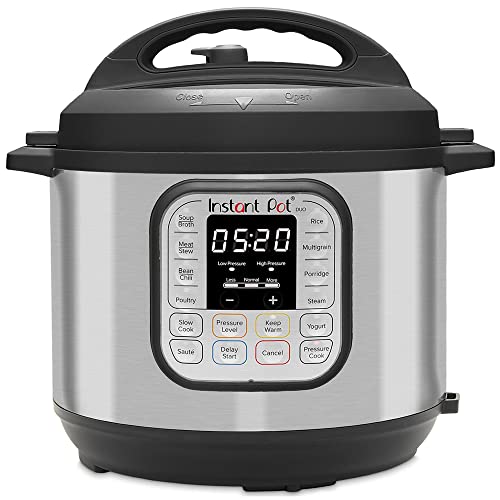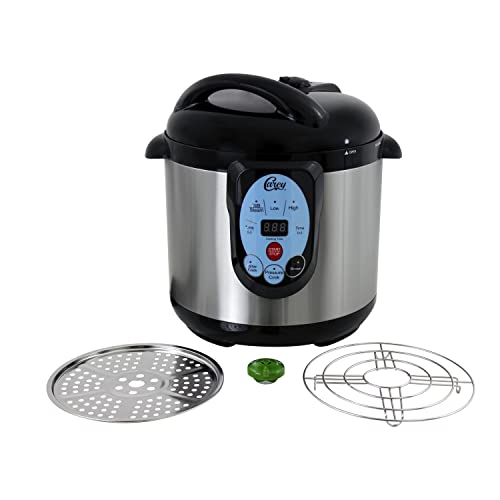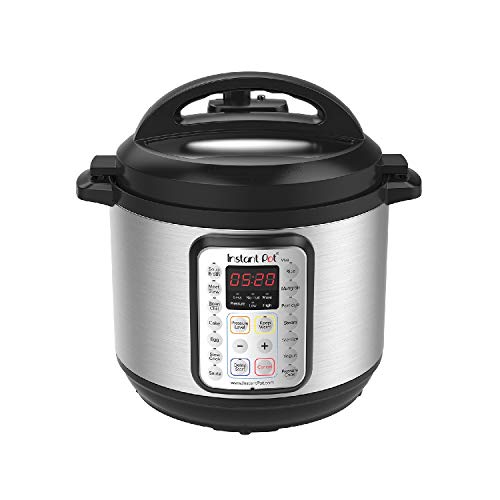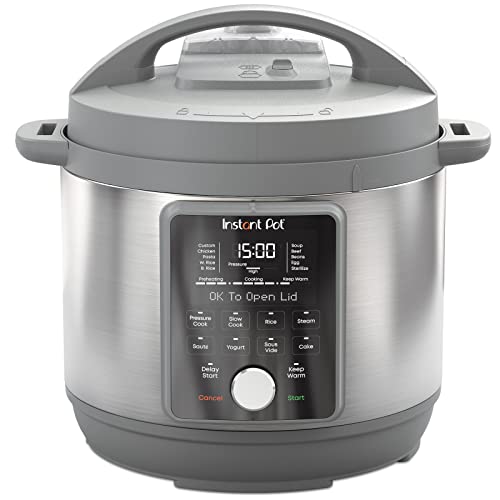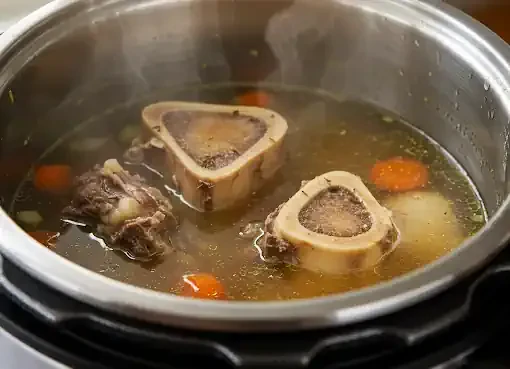Introduction
In the bustling world of culinary innovation and time-saving techniques, few kitchen appliances have made as significant a resurgence as the pressure cooker. Once relegated to the realm of our grandmothers' kitchens, pressure cookers have experienced a remarkable renaissance in recent years, thanks to their ability to whip up hearty meals in a fraction of the time it takes using traditional methods.
Brief History of Pressure Cooking
The concept of pressure cooking dates back to the 17th century when French physicist Denis Papin invented the steam digester, an early precursor to the modern pressure cooker. However, it wasn't until the 20th century that pressure cookers became a staple in household kitchens around the world. With advancements in technology and design, pressure cookers evolved from rudimentary contraptions to safe and efficient appliances that revolutionized meal preparation.
Rising Popularity of Pressure Cookers in Modern Kitchens
In recent years, pressure cookers have experienced a resurgence in popularity, fueled by the growing demand for time-saving kitchen gadgets among busy households. The allure of being able to cook tender, flavorful meals in a fraction of the time has made pressure cookers a favorite tool for home cooks, amateur chefs, and culinary enthusiasts alike.
Introduction to Beef Stew as a Classic Comfort Food
At the heart of this pressure cooker renaissance lies the enduring appeal of classic comfort foods like beef stew. Warm, hearty, and bursting with rich flavors, beef stew has long been a cherished dish in households around the world. Whether enjoyed on a chilly winter evening or as a comforting meal after a long day, beef stew has a way of satisfying both the stomach and the soul.
As we delve into the world of pressure cooker recipes for beef stew, we'll explore the history of pressure cooking, the reasons behind its resurgence in modern kitchens, and the timeless allure of beef stew as the ultimate comfort food. So, grab your apron and get ready to embark on a culinary journey that combines the best of tradition and innovation.
Understanding Pressure Cooking
Pressure cooking is a cooking method that utilizes steam pressure to rapidly cook food. This innovative technique has gained popularity for its ability to drastically reduce cooking times while preserving the natural flavors and nutrients of ingredients.
How Pressure Cookers Work
At the core of a pressure cooker's functionality lies the principle of increasing the boiling point of water under pressure. When the lid is sealed and heat is applied, steam builds up inside the cooker, raising the internal pressure. This elevated pressure allows food to cook at temperatures higher than the standard boiling point of water, resulting in faster cooking times.
Pressure cookers typically consist of a sturdy pot with a tightly sealed lid equipped with a pressure release valve. This design ensures that steam cannot escape during the cooking process, thereby maintaining the high pressure needed for efficient cooking.
Benefits of Pressure Cooking for Beef Stew
When it comes to preparing beef stew, pressure cooking offers several distinct advantages:
Time Efficiency: Pressure cookers can reduce cooking times by up to 70%, making them ideal for busy individuals seeking to enjoy a homemade meal without spending hours in the kitchen.
Tenderization: The high pressure and steam in a pressure cooker break down tough meat fibers more effectively than conventional cooking methods, resulting in tender, melt-in-your-mouth beef in a fraction of the time.
Flavor Infusion: The sealed environment of a pressure cooker traps moisture and flavors, allowing the ingredients to meld together beautifully and intensify the taste of the beef, vegetables, and seasonings.
Nutrient Retention: Unlike boiling or simmering, which can leach nutrients from ingredients, pressure cooking minimizes nutrient loss by cooking food quickly at high temperatures.
Tips for Using a Pressure Cooker Safely
While pressure cookers offer numerous benefits, it's essential to use them safely to avoid accidents. Here are some tips to ensure safe pressure cooker usage:
Follow the Manufacturer's Instructions: Familiarize yourself with the specific instructions and safety guidelines provided by the manufacturer of your pressure cooker.
Check the Seals: Before each use, inspect the rubber sealing ring and pressure release valves for any signs of wear or damage. A proper seal is crucial for maintaining pressure and preventing steam from escaping.
Use Sufficient Liquid: Always ensure that your pressure cooker contains enough liquid to generate steam and maintain pressure throughout the cooking process. Insufficient liquid can lead to burnt food or damage to the cooker.
Release Pressure Safely: When the cooking time is complete, follow the recommended methods for releasing pressure from the cooker, whether it's natural release or quick release. Never force open the lid until all pressure has been released.
By understanding how pressure cookers work, recognizing the benefits they offer for beef stew preparation, and following safety precautions, you can harness the power of this versatile kitchen appliance to create delicious and nutritious meals with ease.
Essential Ingredients and Equipment
To create a delicious beef stew using a pressure cooker, it's essential to carefully select the right ingredients and equipment. From choosing the perfect cut of beef to selecting the freshest vegetables and herbs, every component plays a crucial role in achieving a flavorful and satisfying dish.
Selection of Beef Cuts for Stewing
The key to a tender and succulent beef stew lies in choosing the right cut of meat. Here are some popular options for beef stew:
Chuck Roast: Known for its rich flavor and marbling, chuck roast is a classic choice for beef stew. It contains enough connective tissue to break down during cooking, resulting in tender, melt-in-your-mouth meat.
Beef Brisket: Brisket is another excellent option for beef stew, prized for its deep, beefy flavor and tender texture when cooked low and slow.
Bottom Round: This lean cut of beef is budget-friendly and becomes incredibly tender when cooked in a pressure cooker. While it lacks the marbling of chuck roast, it still delivers robust flavor and a satisfyingly hearty texture.
Regardless of the cut you choose, aim for pieces that are well-marbled with fat and have a good balance of meat and connective tissue. Trim any excess fat and cut the beef into bite-sized chunks for even cooking.
Vegetables, Herbs, and Spices for Flavor Enhancement
In addition to the beef, a medley of vegetables, herbs, and spices adds depth and complexity to your beef stew. Consider including the following ingredients:
Onions: Yellow or white onions provide a savory base for the stew and add sweetness as they cook down.
Carrots: Carrots lend natural sweetness and vibrant color to the stew while providing a hearty texture.
Celery: Celery contributes a subtle herbal note and adds texture to the stew.
Potatoes: Russet or Yukon Gold potatoes are excellent choices for beef stew, providing creamy texture and serving as a natural thickening agent.
Garlic: Fresh garlic adds aromatic flavor to the stew, enhancing its overall depth and complexity.
Herbs: Fresh herbs like thyme, rosemary, and bay leaves infuse the stew with earthy aromas and enhance the savory flavor profile.
Spices: Warm spices such as paprika, cumin, and black pepper add a hint of heat and complexity to the stew, while salt enhances the natural flavors of the ingredients.
Types of Pressure Cookers and Recommended Models
When it comes to pressure cookers, there are several types to choose from, each offering unique features and functionalities:
Electric Pressure Cookers: Electric pressure cookers, such as the Instant Pot, are user-friendly and versatile, offering multiple cooking functions in addition to pressure cooking. They often come with programmable settings and safety features, making them ideal for beginners and experienced cooks alike.
Stovetop Pressure Cookers: Stovetop pressure cookers operate over a burner and require manual monitoring of pressure levels. They are typically more durable and offer higher pressure settings than electric models, making them suitable for professional kitchens or avid home cooks seeking precise control over the cooking process.
Recommended models may vary depending on your budget, cooking needs, and personal preferences. Be sure to research different brands and read customer reviews to find a pressure cooker that meets your requirements and delivers reliable performance for preparing delicious beef stew.
Basic Beef Stew Recipe
Here's a simple and delicious beef stew recipe that you can prepare effortlessly in your pressure cooker. Packed with tender beef, hearty vegetables, and flavorful broth, this dish is sure to become a family favorite.
Ingredients:
2 pounds (900g) beef chuck roast, cut into 1-inch cubes
2 tablespoons olive oil
1 onion, chopped
3 cloves garlic, minced
2 carrots, peeled and diced
2 stalks celery, diced
2 potatoes, peeled and cubed
4 cups (946ml) beef broth
1 tablespoon tomato paste
2 bay leaves
1 teaspoon dried thyme
Salt and pepper to taste
Chopped fresh parsley for garnish
Instructions:
Prepare the Beef: Season the beef cubes generously with salt and pepper. Set aside.
Sauté the Aromatics: Set your pressure cooker to "Sauté" mode and heat the olive oil. Add the chopped onion and cook until softened, about 3-4 minutes. Stir in the minced garlic and cook for another 1-2 minutes until fragrant.
Brown the Beef: Add the seasoned beef cubes to the pressure cooker in batches, making sure not to overcrowd the pot. Brown the beef on all sides, about 2-3 minutes per batch. Remove the browned beef from the pressure cooker and set aside.
Deglaze the Pot: Pour a splash of beef broth into the pressure cooker and scrape up any browned bits from the bottom of the pot with a wooden spoon. This step adds depth of flavor to the stew.
Combine Ingredients: Return the browned beef cubes to the pressure cooker. Add the diced carrots, celery, potatoes, tomato paste, bay leaves, dried thyme, and remaining beef broth. Stir well to combine.
Pressure Cook: Secure the lid on the pressure cooker and set the valve to the sealing position. Cook on high pressure for 25 minutes.
Release Pressure: Once the cooking time is complete, allow the pressure to release naturally for 10 minutes, then carefully release any remaining pressure using the quick-release method.
Adjust Seasoning: Taste the stew and adjust the seasoning with salt and pepper if necessary.
Serve: Ladle the hot beef stew into bowls, garnish with chopped fresh parsley, and serve immediately.
Gluten-Free and Low-Carb Options:
Ensure that the beef broth and tomato paste you use are gluten-free to keep the stew gluten-free.
To make the stew low-carb, you can omit the potatoes or substitute them with low-carb alternatives such as cauliflower florets or turnips.
Cooking Times and Pressure Settings:
Cooking time: 25 minutes on high pressure.
Pressure setting: High pressure (typically around 10-12 psi).
Allow natural release for 10 minutes before using the quick-release method to release any remaining pressure.
Following these instructions will yield a hearty and flavorful beef stew that's perfect for any occasion. Feel free to customize the recipe with your favorite vegetables and spices to suit your taste preferences.
Creative Beef Stew Variations
Elevate your beef stew game with these creative variations inspired by different culinary traditions. From the umami-rich flavors of Asia to the vibrant spices of the Mediterranean, these unique twists will add excitement to your pressure cooker repertoire.
Asian-Inspired Beef Stew with Soy Sauce and Ginger
Ingredients:
2 pounds (900g) beef chuck roast, cut into 1-inch cubes
2 tablespoons vegetable oil
1 onion, sliced
3 cloves garlic, minced
1-inch piece of ginger, grated
2 carrots, sliced
2 stalks celery, sliced
4 cups (946ml) beef broth
1/4 cup (60ml) soy sauce
2 tablespoons rice vinegar
1 tablespoon brown sugar
1 tablespoon cornstarch (optional, for thickening)
Sliced green onions and sesame seeds for garnish
Instructions:
Follow steps 1-4 of the basic beef stew recipe.
In the pressure cooker, add the sliced onion, minced garlic, and grated ginger. Sauté until fragrant, about 2 minutes.
Return the browned beef cubes to the pressure cooker. Add the sliced carrots, celery, beef broth, soy sauce, rice vinegar, and brown sugar. Stir well to combine.
Secure the lid on the pressure cooker and cook on high pressure for 25 minutes.
Once the cooking time is complete, allow the pressure to release naturally for 10 minutes, then use the quick-release method to release any remaining pressure.
If desired, mix cornstarch with a tablespoon of water to create a slurry. Stir the slurry into the stew to thicken the broth.
Serve the Asian-inspired beef stew hot, garnished with sliced green onions and sesame seeds.
Mediterranean-Style Beef Stew with Olives and Sun-Dried Tomatoes
Ingredients:
2 pounds (900g) beef chuck roast, cut into 1-inch cubes
2 tablespoons olive oil
1 onion, diced
3 cloves garlic, minced
1 teaspoon dried oregano
1 teaspoon dried thyme
1 cup (150g) Kalamata olives, pitted
1/2 cup (75g) sun-dried tomatoes, chopped
4 cups (946ml) beef broth
1/2 cup (120ml) red wine (optional)
Salt and pepper to taste
Chopped fresh parsley for garnish
Instructions:
Follow steps 1-4 of the basic beef stew recipe.
In the pressure cooker, heat the olive oil and sauté the diced onion until softened, about 3-4 minutes. Add the minced garlic, dried oregano, and dried thyme, and cook for an additional 1-2 minutes.
Return the browned beef cubes to the pressure cooker. Add the Kalamata olives, sun-dried tomatoes, beef broth, and red wine (if using). Stir well to combine.
Secure the lid on the pressure cooker and cook on high pressure for 25 minutes.
Once the cooking time is complete, allow the pressure to release naturally for 10 minutes, then use the quick-release method to release any remaining pressure.
Taste the stew and adjust the seasoning with salt and pepper if necessary.
Serve the Mediterranean-style beef stew hot, garnished with chopped fresh parsley.
Spicy Beef Stew with Chili Peppers and Cumin
Ingredients:
2 pounds (900g) beef chuck roast, cut into 1-inch cubes
2 tablespoons vegetable oil
1 onion, chopped
3 cloves garlic, minced
2 red chili peppers, seeded and diced
1 tablespoon ground cumin
1 teaspoon smoked paprika
1 can (14 oz/400g) diced tomatoes
4 cups (946ml) beef broth
1 cup (240ml) beer or beef stock
Salt and pepper to taste
Chopped fresh cilantro for garnish
Instructions:
Follow steps 1-4 of the basic beef stew recipe.
In the pressure cooker, heat the vegetable oil and sauté the chopped onion until translucent, about 3-4 minutes. Add the minced garlic, diced chili peppers, ground cumin, and smoked paprika, and cook for an additional 1-2 minutes.
Return the browned beef cubes to the pressure cooker. Add the diced tomatoes (with their juices), beef broth, and beer or beef stock. Stir well to combine.
Secure the lid on the pressure cooker and cook on high pressure for 25 minutes.
Once the cooking time is complete, allow the pressure to release naturally for 10 minutes, then use the quick-release method to release any remaining pressure.
Taste the stew and adjust the seasoning with salt and pepper if necessary.
Serve the spicy beef stew hot, garnished with chopped fresh cilantro.
These creative beef stew variations offer a delightful departure from the traditional recipe, infusing global flavors and spices to tantalize your taste buds. Experiment with different ingredients and seasonings to customize these recipes to your liking and enjoy a culinary adventure in your own kitchen.
Tips for Perfecting Beef Stew
Mastering the art of beef stew in a pressure cooker requires attention to detail and a few tried-and-true techniques. From achieving tender beef to balancing flavors and ensuring optimal storage, these tips will help you perfect your beef stew every time.
Techniques for Tenderizing Beef in a Pressure Cooker
Choose the Right Cut: Opt for well-marbled cuts of beef with a good balance of meat and connective tissue, such as chuck roast or beef brisket. These cuts are rich in collagen, which breaks down during cooking, resulting in tender, succulent meat.
Brown the Beef: Searing the beef cubes before pressure cooking adds depth of flavor and helps to lock in moisture. Use the "Sauté" function on your pressure cooker to brown the beef in batches, ensuring that each piece develops a golden crust.
Cook at High Pressure: Cooking beef stew at high pressure helps to break down tough muscle fibers quickly, resulting in tender meat in a fraction of the time. Follow the recommended cooking times and pressure settings for optimal results.
Allow for Natural Release: After the cooking time is complete, allow the pressure to release naturally for a few minutes before using the quick-release method. This gradual release of pressure helps to prevent the meat from becoming tough or stringy.
Adjusting Seasoning and Thickness of the Stew
Taste and Adjust: Always taste your beef stew before serving and adjust the seasoning as needed. Add more salt, pepper, or herbs to enhance the flavor profile to your liking.
Thicken as Desired: If you prefer a thicker stew, you can add a cornstarch slurry during the cooking process or simmer the stew uncovered after pressure cooking to reduce the liquid and concentrate the flavors.
Balance the Flavors: If your stew is too salty, you can balance the flavors by adding a squeeze of lemon juice or a spoonful of sugar to counteract the saltiness. Conversely, if the stew is too acidic, you can add a splash of cream or a dollop of honey to mellow out the flavors.
Storing and Reheating Beef Stew Leftovers
Cool Properly: Allow leftover beef stew to cool to room temperature before transferring it to an airtight container. Refrigerate or freeze the stew within two hours of cooking to prevent bacterial growth.
Reheat Safely: When reheating beef stew, ensure that it reaches an internal temperature of 165°F (74°C) to kill any potential bacteria. You can reheat the stew on the stovetop over low heat or in the microwave in short intervals, stirring occasionally.
Add Moisture if Needed: If the stew thickens upon cooling, you can add a splash of broth or water to loosen it up before reheating. This will help to restore the stew to its original consistency and prevent it from drying out.
By following these tips for tenderizing beef, adjusting seasoning, and properly storing and reheating leftovers, you'll be well-equipped to achieve beef stew perfection in your pressure cooker. With a little practice and experimentation, you'll soon become a master of this comforting and satisfying dish.
Pairing Beef Stew with Side Dishes
Enhance your beef stew experience by pairing it with complementary side dishes and beverages. From classic accompaniments to creative vegetable sides and refreshing beverages, these pairings will elevate your meal to new heights of flavor and enjoyment.
Classic Accompaniments such as Crusty Bread or Mashed Potatoes
Crusty Bread: Serve slices of crusty bread alongside your beef stew to soak up the savory broth and add a satisfying crunch to each bite. Choose a hearty loaf like French baguette or rustic sourdough for the perfect pairing.
Mashed Potatoes: Creamy mashed potatoes are a classic companion to beef stew, providing a comforting and hearty base for the rich flavors of the stew. Whip up a batch of buttery mashed potatoes and serve them alongside or atop the stew for a delicious combination.
Suggestions for Vegetable Side Dishes to Complement the Stew
Roasted Root Vegetables: Roasted carrots, parsnips, and turnips add sweetness and earthiness to your meal, complementing the savory flavors of the beef stew. Toss the vegetables with olive oil, salt, and herbs, then roast them in the oven until tender and caramelized.
Sauteed Greens: Lighten up your meal with a side of sautéed greens such as spinach, kale, or Swiss chard. Cooked with garlic and olive oil until wilted, these greens provide a fresh and nutritious contrast to the richness of the stew.
Steamed Broccoli or Green Beans: For a simple and nutritious side dish, steam broccoli florets or green beans until tender-crisp. Season them with a sprinkle of salt and pepper and serve them alongside the beef stew for a pop of color and texture.
Beverage Pairings, including Wine, Beer, and Non-Alcoholic Options
Red Wine: A robust red wine such as Cabernet Sauvignon, Merlot, or Syrah pairs beautifully with beef stew, complementing its rich flavors and hearty texture. Choose a full-bodied wine with notes of dark fruit and spice for the perfect match.
Beer: Opt for a malty and slightly sweet beer like a brown ale or stout to accompany your beef stew. The caramelized flavors and smooth mouthfeel of these beers complement the savory richness of the stew, creating a harmonious pairing.
Non-Alcoholic Options: If you prefer a non-alcoholic beverage, consider pairing your beef stew with sparkling water, iced tea, or apple cider. These refreshing drinks cleanse the palate and provide a welcome contrast to the hearty flavors of the stew.
By pairing your beef stew with classic side dishes and carefully selected beverages, you'll create a well-balanced and memorable dining experience that's sure to delight your taste buds and satisfy your cravings. Experiment with different combinations to discover your favorite pairings and enjoy the ultimate comfort meal.
Troubleshooting Common Issues
Even with careful preparation, unexpected challenges may arise when making beef stew in a pressure cooker. Whether you're faced with overcooked beef, a stew that's too thick or too thin, or a lack of depth in flavor, these troubleshooting tips will help you overcome common issues and salvage your dish.
Dealing with Overcooked or Undercooked Beef
Overcooked Beef: If your beef stew is overcooked and the meat is tough, try salvaging the dish by shredding the beef and incorporating it into a soup, chili, or pasta sauce where the texture of the meat is less crucial. Alternatively, add additional liquid to the stew and simmer it gently on the stovetop until the meat becomes tender.
Undercooked Beef: If the beef in your stew is undercooked, return the pressure cooker to high pressure and cook the stew for an additional 5-10 minutes. Alternatively, remove the undercooked beef cubes from the stew and cook them separately until tender, then return them to the pot before serving.
Thickening or Thinning Out the Stew Consistency
Thickening the Stew: If your stew is too thin, you can thicken it by making a slurry with cornstarch or flour. Mix equal parts cornstarch or flour with cold water to create a smooth paste, then stir the slurry into the hot stew and simmer until thickened to your desired consistency.
Thinning Out the Stew: If your stew is too thick, you can thin it out by adding additional broth, water, or wine until it reaches the desired consistency. Adjust the seasoning as needed to maintain a balanced flavor profile.
Addressing Flavor Imbalance or Lack of Depth
Enhance Seasoning: If your stew lacks depth of flavor, try adjusting the seasoning with salt, pepper, and additional herbs and spices. Taste the stew and add small amounts of seasoning gradually until the flavors are well-balanced and satisfying.
Add Umami Boosters: To enhance the savory depth of your stew, consider adding umami-rich ingredients such as Worcestershire sauce, soy sauce, fish sauce, or tomato paste. These ingredients add complexity and depth to the flavor profile of the stew.
Brighten with Acid: If your stew tastes flat or dull, brighten it up with a splash of acid from citrus juice (lemon or lime), vinegar (red wine vinegar or balsamic vinegar), or wine. Acidic ingredients help to balance the flavors and add brightness to the dish.
By employing these troubleshooting techniques, you can overcome common issues that may arise when making beef stew in a pressure cooker and salvage your dish with ease. With a little creativity and ingenuity, you'll be able to transform any mishap into a delicious and satisfying meal that's sure to impress.
Expert Tips from Renowned Chefs
Unlock the secrets to perfecting beef stew with insights from professional chefs who have honed their craft in kitchens around the world. From enhancing flavors to mastering pressure cooker usage, these expert tips will elevate your cooking game and help you create unforgettable beef stew dishes.
Insights from Professional Chefs on Enhancing Beef Stew Flavors
Layer Flavors: Professional chefs often emphasize the importance of layering flavors when creating beef stew. Start by building a flavor base with aromatics like onions, garlic, and herbs, then add depth with umami-rich ingredients such as tomato paste, Worcestershire sauce, or soy sauce.
Use Quality Ingredients: Selecting high-quality ingredients is key to achieving exceptional flavor in beef stew. Choose fresh, seasonal vegetables, flavorful cuts of beef, and rich, homemade broth whenever possible to enhance the overall taste of the dish.
Balance Sweetness and Acidity: Achieving a balanced flavor profile is crucial in beef stew. Professional chefs recommend balancing sweetness with acidity by adding a splash of vinegar, wine, or citrus juice to brighten the flavors and cut through the richness of the stew.
Innovative Techniques for Elevating Traditional Beef Stew Recipes
Infuse with Aromatics: Experiment with infusing your beef stew with aromatic spices and herbs to add complexity and depth to the dish. Consider adding ingredients like star anise, cinnamon, cloves, or fresh ginger for a unique twist on traditional beef stew flavors.
Finish with Fresh Herbs: Elevate the freshness of your beef stew by adding a handful of chopped fresh herbs just before serving. Herbs like parsley, cilantro, or basil add a burst of flavor and brightness to the dish, enhancing its overall appeal.
Incorporate Ethnic Influences: Draw inspiration from different culinary traditions to create innovative variations of beef stew. Explore the flavors of global cuisines such as Indian, Moroccan, or Thai by incorporating spices, herbs, and ingredients characteristic of these regions.
Advice for Home Cooks on Mastering Pressure Cooker Usage
Read the Manual: Familiarize yourself with the instruction manual of your pressure cooker to understand its features, settings, and safety precautions. Follow the manufacturer's guidelines closely to ensure safe and successful pressure cooking experiences.
Start with Simple Recipes: For novice pressure cooker users, start with simple recipes like beef stew to build confidence and familiarize yourself with the appliance. As you become more comfortable, you can experiment with more complex dishes and techniques.
Practice Patience: Patience is key when using a pressure cooker. Allow the cooker to come to pressure gradually, and resist the temptation to open the lid before the pressure has been fully released to avoid accidents and ensure proper cooking results.
By incorporating these expert tips from renowned chefs into your beef stew cooking repertoire, you'll learn how to enhance flavors, explore innovative techniques, and master the art of pressure cooker usage like a pro. With dedication, practice, and a spirit of culinary adventure, you'll soon be creating beef stew dishes that rival those of the finest restaurants.
Exploring Cultural Influences on Beef Stew
Beef stew, a beloved comfort food enjoyed in kitchens around the world, showcases the rich tapestry of culinary traditions and cultural influences that have shaped its evolution over centuries. From hearty European stews to spicy Asian curries, beef stew recipes vary widely across different regions, each reflecting the unique ingredients, flavors, and cooking techniques of its cultural heritage.
Regional Variations of Beef Stew Recipes Around the World
European Stews: In Europe, beef stew takes on various forms, from the hearty Irish stew made with tender beef, potatoes, carrots, and onions, to the rich and complex Hungarian goulash flavored with paprika and served with dumplings. French beef bourguignon features tender beef simmered in red wine with mushrooms, onions, and bacon, while Italian beef ragu is slow-cooked with tomatoes, garlic, and aromatic herbs.
Asian Curries: In Asia, beef stew recipes are often transformed into fragrant and spicy curries. In India, beef curry is prepared with a blend of spices such as cumin, coriander, and turmeric, while Thai beef massaman curry features tender beef simmered in coconut milk with potatoes, peanuts, and spices. Japanese beef stew, known as nikujaga, combines beef, potatoes, and vegetables in a sweet and savory soy sauce-based broth.
Latin American Stews: Latin American cuisine offers a diverse array of beef stew recipes influenced by Spanish, African, and indigenous culinary traditions. Mexican beef birria is a spicy and aromatic stew made with tender beef simmered in a rich chili-based sauce, while Colombian sancocho features beef, plantains, potatoes, and corn in a flavorful broth. In Argentina, beef stew known as carbonada criolla is made with beef, sweet potatoes, and squash in a fragrant broth seasoned with paprika and cumin.
Cultural Significance of Beef Stew in Different Cuisines
Comfort Food: Beef stew holds a special place in many cultures as a comforting and nourishing meal enjoyed by families and communities. In colder climates, such as Northern Europe and North America, hearty beef stews provide warmth and sustenance during the long winter months, while in tropical regions like Southeast Asia and the Caribbean, spicy beef stews offer a satisfying meal any time of year.
Celebratory Dishes: In some cultures, beef stew is served as a celebratory dish during holidays and special occasions. In Ireland, for example, Irish stew is a traditional dish enjoyed on St. Patrick's Day, while in France, beef bourguignon is a popular choice for festive gatherings and dinner parties.
Cultural Heritage: Beef stew recipes often reflect the cultural heritage and culinary traditions of a particular region. Ingredients such as spices, herbs, and vegetables used in beef stew recipes may have symbolic significance and reflect the agricultural abundance and culinary preferences of the local community.
How Globalization has Influenced the Evolution of Beef Stew Recipes
Culinary Fusion: Globalization has led to the fusion of culinary traditions and the exchange of ingredients and cooking techniques between different cultures. As a result, modern beef stew recipes often incorporate a blend of flavors and ingredients from around the world, creating innovative and eclectic variations of this classic dish.
Access to Ingredients: Increased access to a diverse range of ingredients through trade and globalization has expanded the culinary repertoire of home cooks and chefs alike. Today, beef stew recipes may feature exotic spices, specialty meats, and seasonal produce sourced from different parts of the world, adding depth and complexity to the dish.
Cross-Cultural Influences: The popularity of beef stew on a global scale has led to cross-cultural influences and the adaptation of traditional recipes to suit local tastes and preferences. For example, Asian-inspired beef stews may incorporate ingredients like lemongrass, ginger, and coconut milk, while European-inspired beef stews may feature bold flavors and spices characteristic of the region.
In conclusion, beef stew serves as a culinary canvas that reflects the diverse cultural influences and culinary traditions of different regions around the world. Whether enjoyed as a comforting family meal or a festive holiday dish, beef stew continues to captivate and inspire home cooks and chefs with its rich history and global appeal.
Pressure Cooker Beef Stew
In conclusion, pressure cooker beef stew stands as a testament to the versatility, convenience, and timeless appeal of this comforting dish. With its rich flavors, tender meat, and hearty vegetables, beef stew prepared in a pressure cooker offers a convenient and efficient way to enjoy a classic comfort food favorite.
Throughout this article, we've explored the ins and outs of pressure cooker beef stew, from understanding the fundamentals of pressure cooking to discovering creative variations inspired by culinary traditions from around the world. We've delved into essential ingredients, equipment, and techniques for achieving perfect results, as well as troubleshooting tips for overcoming common challenges.
The convenience of pressure cooking allows busy home cooks to whip up a batch of beef stew in a fraction of the time it would take using traditional methods, making it an ideal option for weeknight dinners, weekend meal prep, or entertaining guests. Moreover, the versatility of beef stew lends itself to endless experimentation, with opportunities to customize the recipe to suit individual tastes and preferences.
As we've seen, beef stew recipes vary widely across different cultures and regions, each reflecting the unique ingredients, flavors, and cooking techniques of its cultural heritage. Whether you prefer a classic European-style stew, a spicy Asian-inspired curry, or a hearty Latin American creation, there's a beef stew recipe to suit every palate and occasion.
As you embark on your own culinary journey with pressure cooker beef stew, I encourage you to embrace your creativity and experiment with your own variations. Whether you choose to add exotic spices, seasonal vegetables, or regional ingredients, don't be afraid to think outside the box and make the recipe your own.
In the end, the timeless appeal of beef stew lies in its ability to bring people together around the dinner table, fostering warmth, comfort, and connection with every spoonful. So gather your loved ones, fire up your pressure cooker, and savor the simple pleasures of a homemade bowl of beef stew—a dish that transcends borders, cultures, and generations.
Recipe Compilation
For your convenience, here's a compilation of all the beef stew recipes mentioned in this article. Feel free to reference these recipes in your kitchen adventures, experiment with different variations, and explore the rich and diverse world of pressure cooker beef stew.
Basic Beef Stew Recipe
Link to the Basic Beef Stew Recipe
A classic beef stew recipe featuring tender beef, hearty vegetables, and flavorful broth, prepared in a pressure cooker for maximum convenience.
Asian-Inspired Beef Stew with Soy Sauce and Ginger
Link to the Asian-Inspired Beef Stew Recipe
An aromatic and flavorful beef stew infused with the bold flavors of soy sauce and ginger, inspired by Asian culinary traditions.
Mediterranean-Style Beef Stew with Olives and Sun-Dried Tomatoes
Link to the Mediterranean-Style Beef Stew Recipe
A vibrant and savory beef stew featuring the Mediterranean flavors of olives, sun-dried tomatoes, and aromatic herbs.
Spicy Beef Stew with Chili Peppers and Cumin
Link to the Spicy Beef Stew Recipe
A fiery and aromatic beef stew infused with the bold flavors of chili peppers and cumin, perfect for spice enthusiasts.
Additional Resources: For further exploration of pressure cooker recipes, consider checking out the following resources:
Link to Pressure Cooker Cookbook
With these recipes and resources at your disposal, you'll be well-equipped to embark on a culinary adventure in your own kitchen and enjoy the delicious and comforting flavors of pressure cooker beef stew. Happy cooking!

